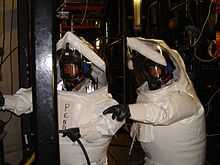Newport Chemical Depot
The Newport Chemical Depot, previously known as the Wabash River Ordnance Works and the Newport Army Ammunition Plant, was a bulk chemical storage and destruction facility in west central Indiana, thirty miles north of Terre Haute operated by the United States Army. The site was used as an RDX, TNT and heavy water production site and also served as the entire production site for VX in the US. The total area of the depot is 7,098 acres (28.72 km2). All VX nerve agent at the site was neutralized by August 8, 2008.[1] It was the third of the Army's nine chemical depots to completely destroy its stockpile.
History
Wabash River Ordnance Works
Newport was originally founded during World War II to produce RDX, a conventional explosive. The site is 6,990 acres (28.3 km2) near the Wabash River. It was built during 1942–1943 by the E I Dupont de Nemours & Co. It was originally called the Wabash River Ordnance Works. The site was selected for the availability of labor, its proximity to a railroad line, electric power and water, its isolated location. Furthermore, the location had to be more than 200 miles (320 km) away from attack.[2]
Given the immediate need for RDX, the plant was designed to copy the existing Woolwich method. Consequently, the plant had less than 1/5 the production of the later Holston Ordnance Works that was based on the improved Bachmann process.[3]
The government acquired 21,986 acres (88.97 km2) for the plant from 62 landowners. It was mostly farmland, but there were 66 clusters of buildings, six cemeteries, and one church. The cemeteries, one apparently dating to 1810, were still maintained as of 1998. Construction started Jan 12, 1942, and production started July 20, 1942.[4]
The plant was mothballed in 1946, but its RDX production was reactivated in 1951 for the Korean War.
Heavy water plant
In 1943–1944, the Newport Army Ammunition Plant added a heavy water plant.[3] During the 1950s, it was used to produce heavy water for the U.S. nuclear weapons program.
Production and stockpiling of Chemical weapons
In 1959, the Army built a VX facility at the site.[5] The facility was known as the Newport Army Chemical Plant. In 1964, the Wabash River Ordnance Works and the Newport Army Chemical Plant were combined and renamed the Newport Army Ammunition Plant.[3]
Beginning in 1961, Newport became a site for chemical weapons manufacturing, producing the entire U.S. stockpile of VX nerve agent. It was next used to store and gradually neutralize the remaining 1,269 short tons (1,151 metric tons) which were present when the U.S. chemical weapons program was stopped and transportation forbidden. The stored VX amounted to 4.1% of the U.S. stockpile of chemical weapons in 1997 when the time the Chemical Weapons Convention came into effect.
Chemical weapons disposal

_container_filled_with_hydrolysate..jpg)

The U.S. Army Chemical Materials Agency designed the Newport Chemical Agent Disposal Facility (NECDF) for the sole purpose of destroying the chemical agent stored at the Newport Chemical Depot. Construction of the NECDF was completed in June 2003. The Army began agent destruction operations in May 2005 and completed operations in August 2008. NECDF’s permit was officially closed in January 2010. Destruction was performed on behalf of the U.S. Army Chemical Materials Agency by Parsons Infrastructure & Technology Inc and more than 500 civilian employees worked at the facility. The site has been the largest employer in Vermillion County since 1941,[6] having employed 1,000 workers.[7]
Process
The Army employed neutralization for the destruction of the chemical agent.[8] The agent was neutralized in steel reactors by thoroughly mixing it with heated sodium hydroxide and water. Control room operators directed and monitored the entire process remotely, using a state-of-the-art control system. Once agent neutralization was verified at the on-site laboratory, the caustic wastewater was placed into on-site intermodal storage containers awaiting transport for final treatment to Veolia Environmental Services in Port Arthur, Texas.[8] This process is a different method than incineration which has been the primary manner of chemical agent destruction at other installations.
Delays
The start of operations was delayed several years due to problems in the arrangements of the disposal of the wastewater (which contains trace - < 20ppm - amounts of VX and 4 byproducts) which at the start of destruction had not been completely solved. Since two companies (Permafix and DuPont) did not accept the wastewater for treatment, it was stored on-site until the Army found another option. Waste was eventually shipped to Port Arthur, Texas where it was processed and incinerated by the company Veolia Environmental Services. A lawsuit delayed the implementation of the shipments but it was dismissed by a federal judge.[9][10] The Organisation for the Prohibition of Chemical Weapons certified that the stockpile was 100 percent destroyed in September 2009.[11]
Incidents
A few incidents have occurred during the destruction process including a 30-gallon spill of VX during processing on June 10, 2005.[12] Further incidents involved spills of the hydrolysate end product. None of these incidents resulted in any injuries.
Base closure
The Army held a Deactivation Ceremony in June 2010 signifying that all activities required for closure of the NECD had been successfully completed. In preparation for closure, the Newport Chemical Depot Reuse Authority (NECDRA) was created to complete a reuse master plan for the NECD. NECDRA and its consultant team worked with the local community to create a plan and implementation strategy for the conversion of the depot to civilian use.[13]
Timeline of VX at Newport

| Year | Event |
|---|---|
| 1962-1968 | VX produced at Newport |
| 1969 | President Richard Nixon issued a unilateral decree halting production and transport of chemical weapons, stranding the last two batches of VX at Newport.[14] |
| 1999 | Contract for disposal of VX awarded to Parsons.[15] |
| 2001 | Company D, 1st Battalion, 502d Infantry, 101st Airborne Division (Air Assault) arrived to secure Newport shortly after the 9/11 attacks.[16] The next month, 1/148 Inf Ohio Army National Guard relieved the 101st Airborne.[17] |
| 2002-2003 | 1/194 Field Artillery (Iowa Army National Guard) protected the depot.[18] |
| 2005 | On May 5th, neutralization operations began destroying the VX.[19] |
| 2008 | On August 8th, neutralization operations completed destruction of all VX stored on the depot.[20] |
| 2010 | On June 17th, the depot conducted a deactivation ceremony and announced that it would will officially vacate the site on the 18th of July.[21] |
See also
References
- ↑ John Pike. "Newport Chemical Depot (NECD) - Newport, Indiana - United States Nuclear Forces". Globalsecurity.org. Retrieved 2014-02-13.
- ↑ MacDonald and Mack Partnership 1984, p. 14,19
- ↑ 3.0 3.1 3.2 MacDonald and Mack Partnership 1984, p. 14
- ↑ MacDonald and Mack Partnership 1984, pp. 20–21
- ↑ MacDonald and Mack Partnership 1984, p. 16
- ↑ "The U.S. Army Chemical Materials Activity (CMA) - Newport, IN". Cma.army.mil. Retrieved 2014-02-13.
- ↑ Kelly, Deb (July 20, 2008), "End of VX neutralization process raises questions about future for Newport Chemical Depot, workers", Tribune Star (Terre Haute, IN), retrieved September 10, 2010
- ↑ 8.0 8.1 Irvine, R.L.; Haraburda, S.S.; and Galbis-Reig C. S. (2004). "Combining SBR systems for chemical and biological treatment: the destruction of the nerve agent VX" 50 (10). Water Science and Technology. pp. 11–18. Retrieved 21 January 2015.
- ↑ Associated Press (25 September 2008). "Judge sides with Army in chemical waste shipments to Port Arthur's Veolia". Beaumont Enterprise. Retrieved 21 January 2015.
- ↑ Ball, David (25 September 2008). "Court dismisses VX lawsuit against Veolia". Port Arthur News. Retrieved 21 January 2015.
- ↑ Organisation for the Prohibition of Chemical Weapons letter NV/ODG/42490/09
- ↑ "C&EN: Latest News - VX Spill At Disposal Facility". Pubs.acs.org. Retrieved 2014-02-13.
- ↑ Colombo, Hayleigh (23 March 2014). "How an Indiana town ridded itself of deadly VX nerve gas". Indianapolis Star. Retrieved 21 January 2015.
- ↑ Mauroni, Albert J. (2000). The America's Struggle with Chemical-biological Warfare. pp. 49–50. ISBN 0-275-96756-5.
- ↑ Staff (20 October 2008). "Nerve Gas Stockpile Destruction at NECD in Newport, IN". Defense Industry Daily. Retrieved 21 January 2015.
- ↑ Haraburda, Scott S. (9 September 2011). "Colonel Scott Haraburda: 9/11 Attacks Had A Tremendous Impact On My Life" (PDF) 85 (51). Spencer Evening World. pp. 1,7. Retrieved 21 January 2015.
- ↑ Ohio Adjutant General's Department (2002). "2001-2002 Annual Report" (PDF). State of Ohio. p. 17. Retrieved 21 January 2015.
- ↑ Shea, Bill (31 July 2010). "Largest deployment of Iowa Army National Guard since WW II begins". The Messenger (of Fort Dodge). Retrieved 21 January 2015.
- ↑ Brackett, Elizabeth (26 May 2005). "Cache of Nerve Gas Destroyed in Indiana Town". PBS News Hour. Retrieved 21 January 2015.
- ↑ Kelly, Deb (12 August 2008). "Last of VX nerve agent eliminated at Newport". Terre Haute Tribune Star. Retrieved 21 January 2015.
- ↑ Greninger, Howard (17 June 2010). "Newport Chemical Depot conducts deactivation ceremony". Terre Haute Tribune Star. Retrieved 21 January 2015.
- General
- Kelly, Deb (July 19, 2008), "Completion of VX neutralization means many things to Valley", Tribune Star (Terre Haute, IN), retrieved September 10, 2010
- Committee on Evaluation of Chemical Events at Army Chemical Agent Disposal Facilities, National Research Council (2002), Evaluation of Chemical Events at Army Chemical Agent Disposal Facilities, The National Academy Press
- Committee on Review and Evaluation of the Army Chemical Stockpile Disposal Program, National Research Council (2002), Review of Proposed Process Changes for Expedited Disposal of the Newport Stockpile of Bulk VX Nerve Agent, The National Academy Press
- Panel on Review and Evaluation of Alternative Chemical Disposal Technologies, National Research Council (1996), Review and Evaluation of Alternative Chemical Disposal Technologies, The National Academy Press
- Committee on Alternative Chemical Demilitarization Technologies, National Research Council (1993), Alternative Technologies for the Destruction of Chemical Agents and Munitions, The National Academy Press
- MacDonald and Mack Partnership (August 1984), Final Properties Report: Newport Army Ammunition Plant (PDF), AD-A175 818, National Park Service
External links
| Wikinews has related news: United States begins testing equipment for demolition of a major VX nerve gas stockpile |
| Wikinews has related news: US_VX_nerve_gas_disposal_test_a_success |
Coordinates: 39°51′2.36″N 87°26′16.94″W / 39.8506556°N 87.4380389°W
| ||||||||||